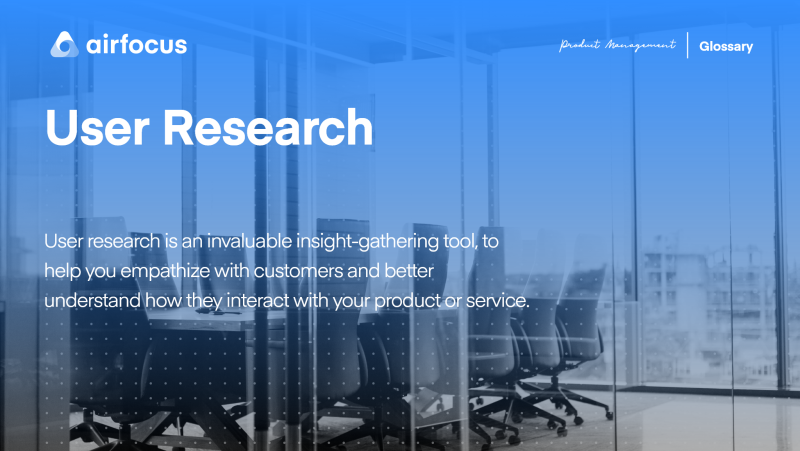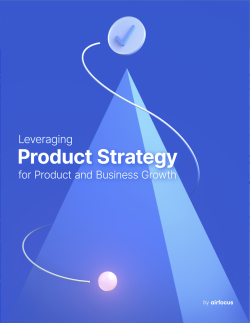User Research
What is user research?
Definition of user research
User research is an invaluable insight-gathering tool, to help you empathize with customers and better understand how they interact with your product or service.
Not to be confused with usability testing, user research can span many methodologies — including qualitative and quantitative. There’s also scope to explore many objectives through user research, which means that speaking directly to consumers can benefit any department in your organization.
For example, marketing may conduct user research to evaluate the impact of a recent campaign. Whereas the product team could run research with the aim of validating new features.
Indeed, until user research is rolled out to test hypotheses or products already in the market, all teams have to go on is their experience and opinion. And, even with the most experienced and professional teams, there’s always a chance for bias to creep in.
As such, user research is a powerful tool for bringing stakeholders together and ensuring their ambitions are entirely user-centric.
Advantages of conducting user research
We’ve already touched upon some of the specific advantages of user research, but before we go into detail on the specific value-adds, it’s worth spending a little time unpacking the higher level benefits.
Put simply, user research helps you understand the behaviors, motivations, intentions, emotions and needs of your target audience.
By observing, speaking to, or co-designing with a target user, teams can really start to design and build products that are relevant, meaningful and — crucially — have users’ interests at heart.
This is also known as user-centric or user-centered ideation.
Without user research, the design process is fueled by "maybe" and "I think so". If you skip past the user feedback part of development, then you miss essential opportunities to assess, validate and improve products, features, and campaigns.
And you don’t need to look very far to find examples of businesses who did just that, and met dire results.
When PepsiCo owned juice brand, Tropicana, modernized its packaging design in 2009, it did conduct user research beforehand — but not with its most loyal users. This oversight led to a $35 million rebrand campaign which was such a departure from the original visual identity that it failed spectacularly.
Everything, from the logo to the print campaign felt so far from the brand and product which advocates knew and loved, Tropicana sales dropped by 20% in the first 2 months, losing the company $30 million in sales.
The lesson here? Tropicana should have used consumer research to identify who their most valuable demographic was, and thoroughly tested the new visual design approach with them.
But user research isn’t only necessary when it comes to multi-million dollar rebrands. Even for the most granular of UX or UI details, getting user feedback on how, why and where is crucial for success.
According to UX and UI studies, first impressions are 94% design related and 90% of smartphone users would buy from a brand again if its app experience was helpful.
Only by conducting user research can we be sure that what we are designing — be it an app, or a pair of shoes — looks and works how its users want and need it to.
Examples and techniques of user research
As Tim Brown, CEO and president of IDEO, explains: “It’s not ‘us versus them’ or even ‘us on behalf of them.’ For a design thinker it has to be ‘us with them'”.
And using the right user research techniques enables a designer, or any other professional, to empathize and see the world through their users’ eyes.
Remember: user research is a team effort — between the researcher and the user. If you want to gain a lot of value from user feedback, you need to prepare.
Here are three examples of user research methodologies, including where in the product lifecycle they could be used and which techniques you’d need to deploy for best results.
User research to reveal unmet needs
Before you’ve even put pen to paper to start designing a consumer product, you should validate that the need you think you’re solving actually exists in your target demographic.
This could be done through focus group discussions or contextual one-on-one interviews — with an emphasis on rich, qualitative feedback.
At this stage, you’re looking to deep-dive into a user’s current situation — what are their pain points? How well do their existing solutions help them achieve the task you’re trying to improve?
For example, if you were looking to design a new washing machine to suit small, inner-city apartments, you’d start by observing the entire ecosystem for that task. Where are dirty clothes stored? How often do users do laundry? Why? How many loads a week? Where do clean goes get hung to dry?
At this stage, it’s important that you listen and really observe the user’s behavior. They may not even know that their current solution is sub-optimal — it’s up to you, to hunt for the implicit cues they are giving you.
User research to test a product prototype
A little further along the design journey, you should find time to pause and test an early mockup of your product solution. How intuitive is the user experience? How engaging is it? Are there any moments of confusion or uncertainty from the user? Do they need a nudge in the right direction to finish a task?
When you’re the designer, it’s easy to assume that everything is easy to understand. Only by sitting down, side-by-side with a user, can you see the product experience clearly.
At this stage, you should ask non-leading questions, such as “What did you expect would happen when you clicked here?”. And ask users to think out-loud, so you can follow their thought process.
If you need to test a digital prototype with a large sample, then quantitative A/B testing is a good option. Just make sure you assess the results in a meaningful way — i.e. time taken to complete the task, rather than a user-given score out of 5 for how much they enjoyed using it.
Prototype testing helped Google create a user-friendly homepage. Before testing, Google’s landing page was so bare that users assumed it hadn’t finished loading! That’s why, following this unexpected feedback, Google added in a little visual noise — in the shape of privacy settings links, etc. — to assure the user the site was ready for action.
User research to identify the most compelling marketing message
Even once a product is set for launch, user research can get you market-ready.
Marketing messages are best devised using consumer insight, so conduct research to explore high potential benefit areas and then again to test the distillation of these benefits into an ad campaign.
Here, give users the tools to articulate their emotional response to the benefits presented to them. Again, ask open-ended questions and consider how you can capture individual response, especially in a focus group set-up.
If you’ve progressed through the design process with frequent pauses for customer feedback, then you should be well prepared for launch.

General FAQ

Glossary categories
Create effective product strategy

Experience the new way of doing product management








